Why do many people see Spain's flag as a fascist symbol?
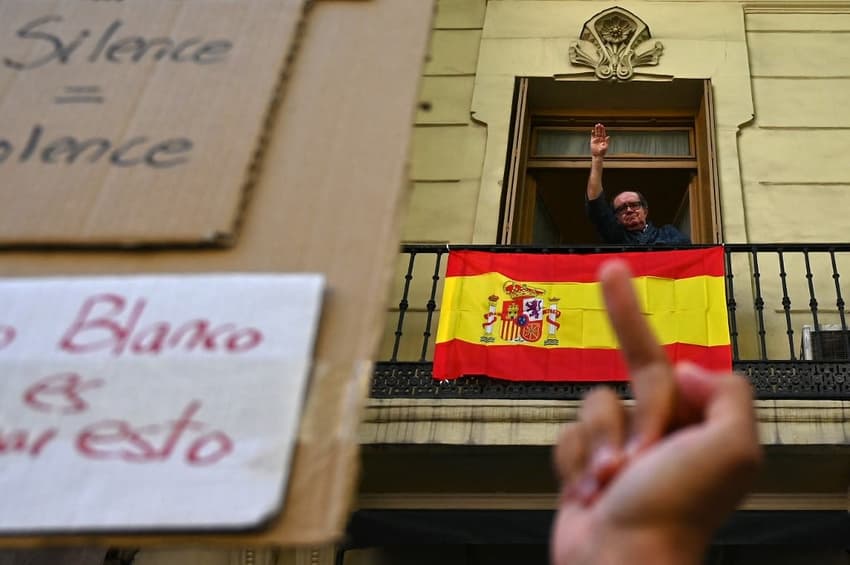
Spain is a country with strong regional identities reflected in its flags, but for some the Spanish national flag is associated with fascism and Spain’s dictatorial past. Is it with good reason?
The distinct identities of Spain's regions are often reflected in their language and customs, but also in their flags.
Catalonia has La Senyera (the official regional flag) and La Estelada (the independence flag with the star), the Basque Country has la La Ikurriña, and even less separatist-minded parts of Spain such as Andalusia and the Canary Islands take pride in their flags.
However, the symbolism of the Spanish national flag - the traditional red and yellow band known as La Rojigualda - is often associated with right-leaning politics, at the least, and fascism at worst.
Much like in England, if you see someone going to the trouble to display the St. George’s flag, or in the United States, with the Confederate flag, you likely have a good idea of what their political ideologies are.
In recent years in Spain, the rise of far-right party Vox has rekindled the debate about the Spanish flag, dug up painful historical memories and divides, and led many to view it as a symbol of Spain’s fascist history.
But why is that?
History
So, what’s the history of the Spanish flag? Well, what is now considered (by some) to be a symbol of fascism initially began as a naval flag.
In 1785, King Carlos III asked his Navy Minister Antonio Valdés to design a new national flag for the Navy because the flag they had at the time was often confused at sea for other nations.
Valdés came up with 12 sketches, all of which are now on display in Madrid, and Carlos III not only changed the flag to something more recognisable to us today - the striking red and yellow colours were thought to be more identifiable at sea - but removed the Bourbon coat of arms.
Then, in 1843, Isabel II declared by Royal Decree that the national flag established should be the same colours as the naval flag and it was flown for the first time in non-naval buildings the following year.
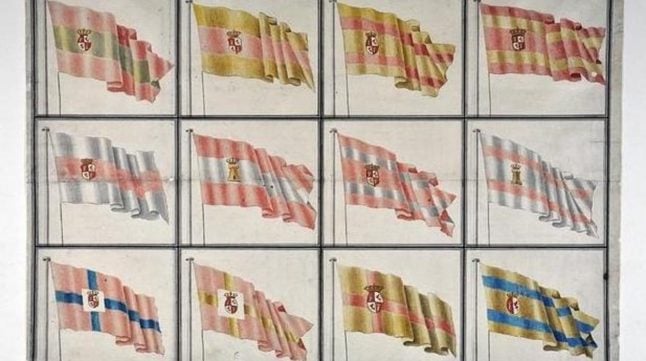
The 12 flags suggested by Antonio Valdés, on display at Madrid's Naval Museum. Image: Museo Naval de Madrid
The politicisation of the Spanish flag
After the Second Spanish Republic was proclaimed in 1931, the flag’s second red band was replaced with a purple band to honour the Comuneros of Castile, a group which revolted against King Charles I in 1520. This modified version was used as the Republican flag during the Civil War, while Franco’s army used the traditional yellow and red flag.
After winning the war, Franco added the Eagle of Saint John to the flag, and it underwent some very minor changes during the dictatorship (which lasted between 193 and 1975), but largely remained the same until Spain’s transition to democracy began.
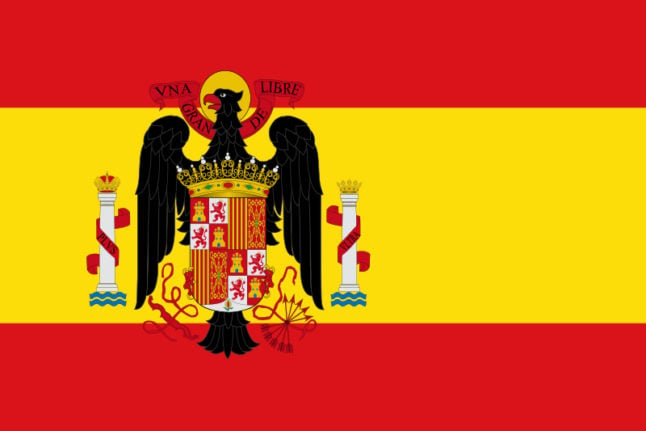
The eagle added to Spain's flag by Franco was also a symbol adopted by the Nazis in Germany. Image: Wikipedia
Some historians have suggested that the republican decision not to embrace the Spanish flag and stick by their own creation laid the foundations for the political divides over the flag’s symbolism that would come in later years.
What's clear is that the Spanish right (and far right) have appropriated the national flag as a symbol of their vision of Spanish history and identity, whilst the Spanish left have missed an opportunity to claim it as their own.
In countries that also had fascist dictatorships, such as Iberian neighbours Portugal, both the right and left take pride in and make use of the flag.
Transition
The Spanish flag that we know today was established in Article 4.1 of the Spanish Constitution of 1978, when the national coat of arms was incorporated, and the more Francoist elements removed.
But the Spanish left hasn’t always viewed the flag as a symbol of fascism. In the years after Spain's democratic transition the left accepted the rojigualda and both PSOE and the Spanish Communist Party used it in electoral and promotional material.
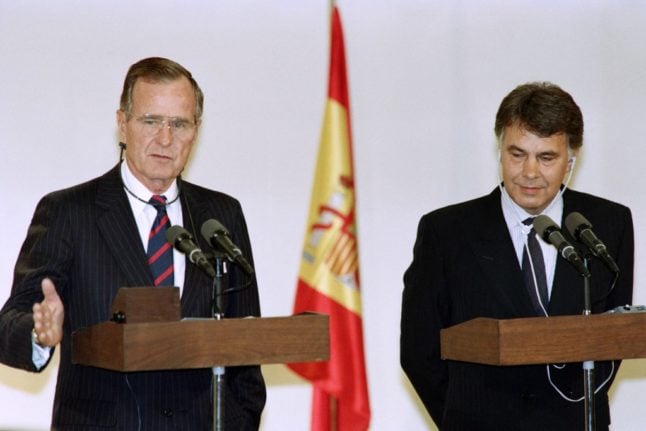
Former US President George Bush (L) and Spain's former Socialist Prime Minister Felipe González in 1991, with the Spanish flag in the background. (Photo by David AKE / AFP)
After more political instability and a failed coup in 1981, for many on the left, embracing the flag signified reconciliation after decades of dictatorship and polarisation.
But by the turn of the 21st century, the Republican tricolour flag began to make a bit of a political comeback as a broader anti-authoritarian, anti-imperial, left-wing symbol.
As war in Iraq began it took on anti-NATO connotations, and as separatist sentiment grew in the Basque Country and Catalonia the traditional flag began being associated with fascism and Francoism again.
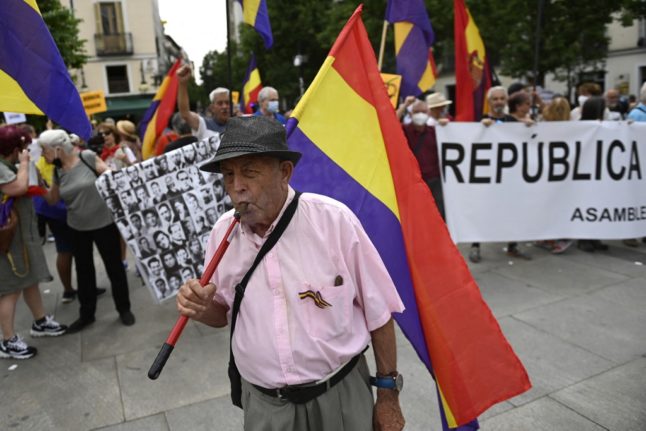
A man holds a Republican flag during an anti-monarchy demonstration in Madrid. (Photo by PIERRE-PHILIPPE MARCOU / AFP)
With the more radical elements of the Spanish left completely turning their back on the national flag, in recent years far-right party Vox has used the flag as a rallying call against separatist regions and re-established the flag as a symbol of what they perceive to be traditional Spanish identity.
The emphasis on a one-flag country is not only an allusion to Vox’s pro-centralisation, anti-separatist politics, but also harks back to the dictatorship when regional identities, flags and languages were restricted.
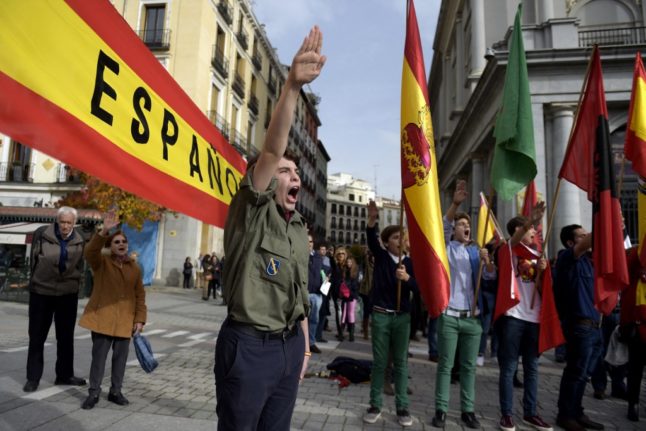
Supporters of Spanish dictator General Francisco Franco perform the fascist salute and hold Spanish flags as they attend the anniversary of the dictator's death in Madrid. (Photo by GERARD JULIEN / AFP)
Vox party leader Santiago Abascal makes heavy use of the flag in his public appearances, social media posts, and Vox memorabilia.
The rise of other regional flags, he believes, is in direct confrontation with the Spanish flag. "It's either our stained, trampled, and spit-at flag,” he said in a speech in 2019, "or our flag waving with pride".
As Spanish politics has become more and more polarised in recent years, flags have re-emerged as divisive political symbols.
Unfortunately, for many people the Spanish flag continues to be an image of Franco’s fascist dictatorship and reignites the historical divisions from the Civil War, rather than being an emblem of different people and regions that are united as one nation (flag-wielding support for the national football team La Roja and other national sport teams are an exception to this, however).
For other parts of the Spanish population, the national flag represents their politics and view of Spanish history and identity. They drape Spanish flags from their balconies or wear red-and-yellow bracelets and belts to showcase their patriotism.
In modern-day Spain, La Rojigualda is still without a doubt a very loaded symbol.
Comments
See Also
The distinct identities of Spain's regions are often reflected in their language and customs, but also in their flags.
Catalonia has La Senyera (the official regional flag) and La Estelada (the independence flag with the star), the Basque Country has la La Ikurriña, and even less separatist-minded parts of Spain such as Andalusia and the Canary Islands take pride in their flags.
However, the symbolism of the Spanish national flag - the traditional red and yellow band known as La Rojigualda - is often associated with right-leaning politics, at the least, and fascism at worst.
Much like in England, if you see someone going to the trouble to display the St. George’s flag, or in the United States, with the Confederate flag, you likely have a good idea of what their political ideologies are.
In recent years in Spain, the rise of far-right party Vox has rekindled the debate about the Spanish flag, dug up painful historical memories and divides, and led many to view it as a symbol of Spain’s fascist history.
But why is that?
History
So, what’s the history of the Spanish flag? Well, what is now considered (by some) to be a symbol of fascism initially began as a naval flag.
In 1785, King Carlos III asked his Navy Minister Antonio Valdés to design a new national flag for the Navy because the flag they had at the time was often confused at sea for other nations.
Valdés came up with 12 sketches, all of which are now on display in Madrid, and Carlos III not only changed the flag to something more recognisable to us today - the striking red and yellow colours were thought to be more identifiable at sea - but removed the Bourbon coat of arms.
Then, in 1843, Isabel II declared by Royal Decree that the national flag established should be the same colours as the naval flag and it was flown for the first time in non-naval buildings the following year.

The politicisation of the Spanish flag
After the Second Spanish Republic was proclaimed in 1931, the flag’s second red band was replaced with a purple band to honour the Comuneros of Castile, a group which revolted against King Charles I in 1520. This modified version was used as the Republican flag during the Civil War, while Franco’s army used the traditional yellow and red flag.
After winning the war, Franco added the Eagle of Saint John to the flag, and it underwent some very minor changes during the dictatorship (which lasted between 193 and 1975), but largely remained the same until Spain’s transition to democracy began.

Some historians have suggested that the republican decision not to embrace the Spanish flag and stick by their own creation laid the foundations for the political divides over the flag’s symbolism that would come in later years.
What's clear is that the Spanish right (and far right) have appropriated the national flag as a symbol of their vision of Spanish history and identity, whilst the Spanish left have missed an opportunity to claim it as their own.
In countries that also had fascist dictatorships, such as Iberian neighbours Portugal, both the right and left take pride in and make use of the flag.
Transition
The Spanish flag that we know today was established in Article 4.1 of the Spanish Constitution of 1978, when the national coat of arms was incorporated, and the more Francoist elements removed.
But the Spanish left hasn’t always viewed the flag as a symbol of fascism. In the years after Spain's democratic transition the left accepted the rojigualda and both PSOE and the Spanish Communist Party used it in electoral and promotional material.

After more political instability and a failed coup in 1981, for many on the left, embracing the flag signified reconciliation after decades of dictatorship and polarisation.
But by the turn of the 21st century, the Republican tricolour flag began to make a bit of a political comeback as a broader anti-authoritarian, anti-imperial, left-wing symbol.
As war in Iraq began it took on anti-NATO connotations, and as separatist sentiment grew in the Basque Country and Catalonia the traditional flag began being associated with fascism and Francoism again.

With the more radical elements of the Spanish left completely turning their back on the national flag, in recent years far-right party Vox has used the flag as a rallying call against separatist regions and re-established the flag as a symbol of what they perceive to be traditional Spanish identity.
The emphasis on a one-flag country is not only an allusion to Vox’s pro-centralisation, anti-separatist politics, but also harks back to the dictatorship when regional identities, flags and languages were restricted.

Vox party leader Santiago Abascal makes heavy use of the flag in his public appearances, social media posts, and Vox memorabilia.
The rise of other regional flags, he believes, is in direct confrontation with the Spanish flag. "It's either our stained, trampled, and spit-at flag,” he said in a speech in 2019, "or our flag waving with pride".
As Spanish politics has become more and more polarised in recent years, flags have re-emerged as divisive political symbols.
Unfortunately, for many people the Spanish flag continues to be an image of Franco’s fascist dictatorship and reignites the historical divisions from the Civil War, rather than being an emblem of different people and regions that are united as one nation (flag-wielding support for the national football team La Roja and other national sport teams are an exception to this, however).
For other parts of the Spanish population, the national flag represents their politics and view of Spanish history and identity. They drape Spanish flags from their balconies or wear red-and-yellow bracelets and belts to showcase their patriotism.
In modern-day Spain, La Rojigualda is still without a doubt a very loaded symbol.
Join the conversation in our comments section below. Share your own views and experience and if you have a question or suggestion for our journalists then email us at [email protected].
Please keep comments civil, constructive and on topic – and make sure to read our terms of use before getting involved.
Please log in here to leave a comment.